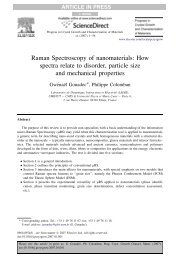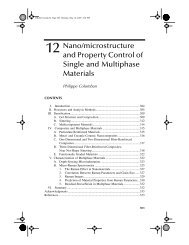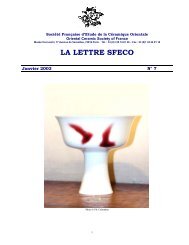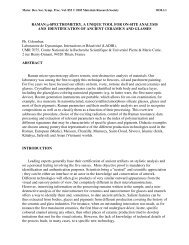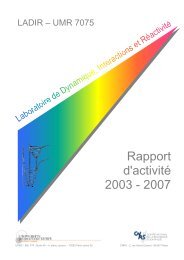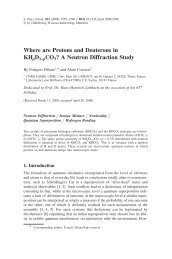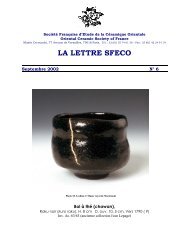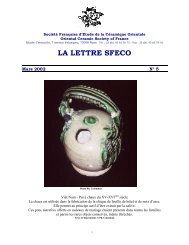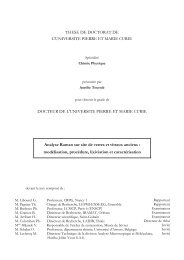Structure and dynamics of the symmetric hydrogen ... - ResearchGate
Structure and dynamics of the symmetric hydrogen ... - ResearchGate
Structure and dynamics of the symmetric hydrogen ... - ResearchGate
You also want an ePaper? Increase the reach of your titles
YUMPU automatically turns print PDFs into web optimized ePapers that Google loves.
Ž .Chemical Physics 244 1999 387–403www.elsevier.nlrlocaterchemphys<strong>Structure</strong> <strong>and</strong> <strong>dynamics</strong> <strong>of</strong> <strong>the</strong> <strong>symmetric</strong> <strong>hydrogen</strong> bond inpotassium <strong>hydrogen</strong> maleate: a neutron scattering studyF. Fillaux a,) , N. Leygue a , J. Tomkinson b , A. Cousson c , W. Paulus caLab. de Dynamique, Interactions et ReactiÕite, ´ ´ Centre Nat. de la Rech. Scientifique ( LADIR-CNRS ), 2 rue Henry Dunant, 94320 Thiais,Franceb ISIS Facility, Ru<strong>the</strong>rford Appleton Laboratory, Chilton, Didcot, OX11 0QX, UKcLaboratoire Leon ´ Brillouin ( CEA-CNRS ), CE Saclay, 91191 Gif-sur-YÕette Cedex, FranceReceived 4 February 1999AbstractThe crystal structure <strong>of</strong> potassium <strong>hydrogen</strong> maleate KHŽ OOC–CH5CH–COO.has been studied at 300, 14 <strong>and</strong> 5 Kusing three-dimensional single-crystal neutron diffraction data. There is no evidence for any phase transition. The crystalŽllstructure is orthorhombic, P D ., with four entities in <strong>the</strong> unit cell Ž Zs4 .bcm 2h, in accord with previous X-ray diffractionwork. The ion is nearly planar <strong>and</strong> deviation from C2vsymmetry is negligible. The short internal <strong>hydrogen</strong> bond parallel to<strong>the</strong> c axis, R s2.427Ž.1 A˚O PPP Oat 5 K, is <strong>symmetric</strong>al with <strong>the</strong> proton located at <strong>the</strong> center. Inelastic neutron scatteringŽ .y1INS spectra, from 16 to 4000 cm , <strong>of</strong> <strong>the</strong> fully <strong>hydrogen</strong>ated sample <strong>and</strong> partially deuterated analogues, KHŽOOC–CD5CD–COO. <strong>and</strong> KDŽ OOC–CH5CH–COO ., have been recorded for powdered samples <strong>and</strong> aligned single crystals at 20K. Complex spectral pr<strong>of</strong>iles are observed for <strong>the</strong> stretching mode <strong>of</strong> <strong>the</strong> <strong>hydrogen</strong> bond, naOHO, <strong>and</strong> for <strong>the</strong> totally<strong>symmetric</strong> out-<strong>of</strong>-plane deformation <strong>of</strong> <strong>the</strong> maleate ion. An isotopic mixture <strong>of</strong> KHŽ OOC–CD5CD–COO ., 20%, <strong>and</strong>KDŽ OOC–CD5CD–COO ., 80%, reveals that intermolecular coupling is negligible. Frequencies <strong>and</strong> intensities areamenable to <strong>symmetric</strong>al potential functions with a central minimum between secondary minima at higher energy. The INS<strong>and</strong> infrared b<strong>and</strong> pr<strong>of</strong>iles suggest that <strong>the</strong> planar conformation with C2vsymmetry <strong>of</strong> <strong>the</strong> maleate ring is unstable in excitedvibrational states. The quantum nature <strong>of</strong> <strong>the</strong> <strong>hydrogen</strong> bond is emphasised with <strong>the</strong> concept <strong>of</strong> ‘<strong>hydrogen</strong> bondingrantibonding’states. q 1999 Elsevier Science B.V. All rights reserved.Keywords: Symmetric <strong>hydrogen</strong> bond; Potassium <strong>hydrogen</strong> maleate; Neutron scattering1. IntroductionIn <strong>hydrogen</strong> bonds AH PPP B, it is widely acceptedthat <strong>the</strong> potential energy for <strong>the</strong> motion <strong>of</strong> <strong>the</strong><strong>hydrogen</strong> atom has two minima w1–10 x. For <strong>symmetric</strong>systems AH PPP A, <strong>the</strong> two wells can be equivalent.There are <strong>the</strong>n two tautomeric forms <strong>and</strong> proton) Corresponding author. Tel.: q33-1-49-78-12-83; Fax: q33-1-49-78-13-23; E-mail: fillaux@glvt-cnrs.frtunnelling may occur. For shorter <strong>hydrogen</strong> bonds,<strong>the</strong> distance between <strong>the</strong> two minima decreases <strong>and</strong><strong>the</strong> potential barrier between <strong>the</strong>m may disappear.There remains only a single well <strong>and</strong> <strong>the</strong> <strong>symmetric</strong>structure can be regarded as <strong>the</strong> ‘intermediate-state’for proton transfer in chemical reactions or biologiw11–13x.The mono-anion <strong>of</strong> maleic acid in potassium hy-cal processesdrogen maleate, KHŽ OOC–CH5CH–COO .,ŽFig.1a.is a classic example <strong>of</strong> a <strong>symmetric</strong> intramolec-0301-0104r99r$ - see front matter q 1999 Elsevier Science B.V. All rights reserved.Ž .PII: S0301-0104 99 00153-6
388( )F. Fillaux et al.rChemical Physics 244 1999 387–403Fig. 1. Schematic representation <strong>of</strong> <strong>the</strong> <strong>hydrogen</strong> maleate anion Ž. a<strong>and</strong> <strong>of</strong> <strong>the</strong> crystal structure <strong>of</strong> potassium <strong>hydrogen</strong> maleate at 14 KŽ. b . The dot dash line is going through <strong>the</strong> centre <strong>of</strong> gravity <strong>of</strong>each HCCOO entity.ular <strong>hydrogen</strong> bond. An extremely short O PPP HPPP O bond with length R s2.437 A˚O PPP O<strong>and</strong> <strong>the</strong>proton located at <strong>the</strong> center has been shown bydiffraction studies w14,15 x. Infrared <strong>and</strong> Raman w16–21 x, inelastic neutron scattering Ž INS. w22–24x<strong>and</strong>o<strong>the</strong>r techniques w25–27xare in general agreementthat this strong <strong>hydrogen</strong> bond is, at least statistiw28–30xconverge to <strong>the</strong> conclusion that in solution <strong>hydrogen</strong>cally, <strong>symmetric</strong>al. However, NMR studiesmaleate <strong>and</strong> many o<strong>the</strong>r monoanions <strong>of</strong> diacids existas pairs <strong>of</strong> a<strong>symmetric</strong> equilibrating tautomers withina double-well potential. This was claimed as ‘aremarkably simple counterexample to <strong>the</strong> prevailinghope that a crystal structure describes <strong>the</strong> solutionstructure’ w28 x.Vibrational spectroscopy provides information on<strong>the</strong> proton <strong>dynamics</strong> on a much shorter time scalethan that accessible with NMR or diffraction. However,<strong>the</strong> broad infrared b<strong>and</strong>s below 1800 cm y1typical <strong>of</strong> short <strong>hydrogen</strong> bonds are not fully underw16x. Unfortunately, it is difficult to establishstoodany assignment scheme on <strong>the</strong> basis <strong>of</strong> force-fieldcalculation w17 x, isotopic substitution or polarisationeffects w18,19,21 x. The most straightforward informationwas obtained with <strong>the</strong> INS technique: intenseb<strong>and</strong>s at ;1250 <strong>and</strong> 1650 cm y1 are clearly <strong>the</strong> gOHO <strong>and</strong> d OHO modes, respectively. The assignment<strong>of</strong> <strong>the</strong> naOHO mode, on <strong>the</strong> o<strong>the</strong>r h<strong>and</strong>, is noteasy, partially because <strong>of</strong> technical limitations regardingbackground definition, accessible frequencyrange, resolution <strong>and</strong> intensity definition. Five b<strong>and</strong>sbetween 400 <strong>and</strong> 1000 cm y1 , with ra<strong>the</strong>r modestintensities, were tentatively regarded as combinations<strong>of</strong> n OHO, n OHO <strong>and</strong> ring modes w22 xas. It wasconcluded that <strong>the</strong> naOHO mode most likely splitsinto several components. Thorough investigations <strong>of</strong><strong>the</strong> infrared <strong>and</strong> Raman spectra were in generalagreement with this assignment scheme w19 x. However,in more recent studies, <strong>the</strong> naOHO mode wasreassigned to a very broad b<strong>and</strong> centred at ;800cm y1 with two wide transmission windows at ;800<strong>and</strong> 600 cm y1 due to strong anharmonic interactionwith ring deformations <strong>and</strong> d COO w21 x. The resultingoptical pr<strong>of</strong>ile is composed <strong>of</strong> three broad b<strong>and</strong>sat 545, 700 <strong>and</strong> 990 cm y1 . However, <strong>the</strong> small shift<strong>of</strong> <strong>the</strong> n OHO upon deuteration Ža na OHOrnaODO;1.09.could not be explained. A frequency ratioclose to unity is normally regarded as <strong>the</strong> signature<strong>of</strong> a possible double-well potential w31 x, but this is inconflict with <strong>the</strong> structure <strong>of</strong> <strong>the</strong> <strong>hydrogen</strong>ate maleateat room temperature w14 x.The TFXA spectrometer at <strong>the</strong> ISIS pulsed neutronsource Ž Ru<strong>the</strong>rford Appleton Laboratory, UK.covers a larger frequency range with better resolution<strong>and</strong> intensity measurements than used for previw22x. We have recorded <strong>the</strong> INSous experimentsspectra from 16 to 4000 cm y1 <strong>of</strong> <strong>the</strong> totally <strong>hydrogen</strong>atedsample, KHMH 2, <strong>and</strong> isotopic analoguesKHMD <strong>and</strong> KDMH . Fur<strong>the</strong>rmore, <strong>the</strong> excellent2 2
( )F. Fillaux et al.rChemical Physics 244 1999 387–403 389definition <strong>of</strong> <strong>the</strong> momentum transfer direction for aTFXA-like spectrometer was exploited to study orientedsingle crystals for momentum transfer along<strong>the</strong> OHO stretching mode parallel to <strong>the</strong> c crystalaxis Ž Fig. 1b .. Unfortunately, <strong>the</strong> maleate rings formlayers almost perpendicular to each o<strong>the</strong>r’s <strong>and</strong> it isnot possible to observe extinction for in-plane bendingmodes.The b<strong>and</strong> assignment scheme presented below isin general agreement with previous INS work w22 x,but quite at variance with assignments based oninfrared spectra w21 x. Complex spectral patterns areassigned to <strong>the</strong> naOHO, on <strong>the</strong> one h<strong>and</strong>, <strong>and</strong> to anout-<strong>of</strong>-plane deformation <strong>of</strong> <strong>the</strong> maleate ring, on <strong>the</strong>o<strong>the</strong>r. They confirm spectacular anharmonicity for<strong>the</strong>se vibrations. The energy level schemes are notamenable to <strong>the</strong> usual single or double minimumpotential functions <strong>and</strong> it is necessary to considermore complex potential functions. Since <strong>the</strong> potentialfunction may not be unique, it is <strong>of</strong> primary importanceto determine <strong>the</strong> mean positions <strong>and</strong> temperaturefactors <strong>of</strong> <strong>the</strong> protons in <strong>the</strong> crystal at lowtemperature. The fully <strong>hydrogen</strong>ated potassium <strong>hydrogen</strong>maleate has been studied at 300, 14 <strong>and</strong> 5 K,using three-dimensional single-crystal neutrondiffraction data. In all cases, <strong>the</strong> <strong>hydrogen</strong> maleatering remains planar <strong>and</strong> <strong>the</strong> proton is at <strong>the</strong> center <strong>of</strong><strong>the</strong> <strong>hydrogen</strong> bond. It is <strong>the</strong>n possible to determineprecisely <strong>the</strong> potential functions governing <strong>the</strong> <strong>dynamics</strong>.2. ExperimentalThe samples were obtained by crystallisation fromaqueous solutions Ž H O or D O.2 2 <strong>of</strong> maleic anhydride<strong>and</strong> K 2CO 3. KHMD2was obtained from partiallydeuterated dimethyl fumarate, C6H 6D2O 4,prepared according to Ref. w32 x. This ester was hydrolysed<strong>and</strong> <strong>the</strong> acid was heated at 1608C withphosphoric anhydride, P2O 5, to obtain <strong>the</strong> maleicanhydride. Single crystals were obtained by slowevaporation <strong>of</strong> aqueous solutions.For neutron diffraction measurements, an approximatelycubic sample was cut Ž3=3=3 mm 3. froma large crystal Ž3=3=2 cm 3., <strong>and</strong> tested at roomtemperature. It was <strong>the</strong>n enclosed in an aluminiumcontainer <strong>and</strong> mounted in a helium vapour streamcryostat. Measurements at room temperature, 14 <strong>and</strong>5 K Ž see Table 1.were carried out on a Stoefour-circle diffractometer on <strong>the</strong> 5C2 channel Žls0.8302Ž. 2 A˚. at <strong>the</strong> hot source <strong>of</strong> <strong>the</strong> Orphee ´ reactorŽ Laboratoire Leon ´ Brillouin, Saclay, France ..For INS measurements, platelets parallel to <strong>the</strong>Ž .3a,b plane ;20=20=2 mm grow naturally. Theorientation was confirmed with a polarising microscope.The TFXA spectrometer at <strong>the</strong> ISIS pulsed neutronsource ŽRu<strong>the</strong>rford Appleton Laboratory,Chilton, UK.is an inverted time-<strong>of</strong>-flight spectromew33x. The detectedter with resolution Dvrv;3%spectra, normalised to <strong>the</strong> incident monitor, wereconverted by st<strong>and</strong>ard programs from counts perchannel to <strong>the</strong> conventional scattering functionSŽ Q,v .. The momentum transfer Q is <strong>the</strong> vectordifference between <strong>the</strong> incident <strong>and</strong> scattered wavevectors < k < s2prl <strong>and</strong> < k
390( )F. Fillaux et al.rChemical Physics 244 1999 387–403Table 2Atom coordinates for potassium <strong>hydrogen</strong> maleateAtom xra yr b zrcKŽ. 1 0.2628Ž.3 0.7500 0.00000.2610Ž.2 0.7500 0.00000.2610Ž.3 0.7500 0.0000OŽ. 1 0.4842Ž. 2 0.2965Ž. 1 0.17391Ž.50.4895Ž. 1 0.29438Ž. 5 0.17376Ž.20.4894Ž. 2 0.2942Ž. 1 0.17376Ž.4OŽ. 2 0.2368Ž. 2 0.4195Ž. 1 0.07191Ž.60.23586Ž. 9 0.41932Ž. 6 0.07109Ž.20.2359Ž. 2 0.4194Ž. 1 0.07104Ž.4CŽ. 1 0.2824Ž. 1 0.3968Ž. 1 0.14745Ž.40.28292Ž. 8 0.39632Ž. 5 0.14694Ž.20.2828Ž. 1 0.39637Ž. 9 0.14691Ž.4CŽ. 2 0.0904Ž. 2 0.48852Ž. 9 0.20790Ž.50.08707Ž. 8 0.48966Ž. 5 0.20783Ž.20.0871Ž. 1 0.48989Ž. 9 0.20785Ž.4H21 Ž . y0.0744Ž. 4 0.5650Ž. 2 0.1767Ž.1y0.0813Ž. 2 0.5675Ž. 1 0.17664Ž.6y0.0809Ž. 4 0.5673Ž. 3 0.1767Ž.1HŽ. 1 0.4942Ž. 5 0.2939Ž.3 0.25000.4985Ž. 3 0.2919Ž.2 0.25000.4987Ž. 5 0.2921Ž.3 0.2500For each atom, <strong>the</strong> three rows are, from <strong>the</strong> top, <strong>the</strong> coordinates at300, 14 <strong>and</strong> 5 K.sample. There is a small component Ž Q .H <strong>and</strong> <strong>the</strong>neutron momentum polarisation is:< Q < 25 E0Rs ( Ž 12.< Q < EHfŽy1E <strong>and</strong> E 32 cm .0 f are <strong>the</strong> energies <strong>of</strong> <strong>the</strong> incident<strong>and</strong> scattered neutrons, respectively. At low energyŽy1transfer, R is only moderate ;3 at 100 cm ..However, <strong>the</strong> polarisation improves rapidly, suchthat R;25 at 800 cm y1 . For large energy transfer,any influence <strong>of</strong> Q H can be ignored.The crystals wrapped in aluminium foil weremounted in a closed cycle refrigerator such that <strong>the</strong>momentum transfer component Q 5 was parallel to<strong>the</strong> c crystal axis. For powders, about 3 g <strong>of</strong> sampleswere wrapped in aluminium foil <strong>and</strong> loaded into aclosed cycle refrigerator. For all samples, <strong>the</strong> temperaturewas Ž 20"2.K.Potential functions were calculated using basissets <strong>of</strong> 40 harmonic oscillator wave functions w34,35 x.INS intensities were calculated by numerical integraw36x:SŽ Q ,v . s
( )F. Fillaux et al.rChemical Physics 244 1999 387–403 391Table 4Thermal parameters Ž in A˚2units.for potassium <strong>hydrogen</strong> maleateŽ . Ž . Ž . Ž . Ž . Ž . Ž .Atom U 11 U 22 U 33 U 23 U 13 U 12 U isoKŽ. 1 0.0352Ž. 9 0.0350Ž. 9 0.0303Ž. 9 0.0011Ž.8 0.0000 0.0000 0.03340.0046Ž. 3 0.0054Ž. 3 0.0041Ž. 3 0.0001Ž.2 0.0000 0.0000 0.00470.0055Ž. 6 0.0051Ž. 7 0.0050Ž. 6 0.0004Ž.5 0.0000 0.0000 0.0052OŽ. 1 0.0433Ž. 5 0.0507Ž. 6 0.0261Ž. 7 y0.0023Ž. 4 0.0011Ž. 3 0.0150Ž.4 0.03710.0070Ž. 2 0.0079Ž. 2 0.0044Ž. 2 y0.0001Ž. 1 0.0001Ž. 1 0.0027Ž.1 0.00600.0081Ž. 3 0.0086Ž. 4 0.0040Ž. 3 y0.0002Ž. 2 y0.0002Ž. 2 0.0026Ž.3 0.0063OŽ. 2 0.0526Ž. 6 0.0481Ž. 6 0.0254Ž. 5 0.0020Ž. 5 y0.0050Ž. 3 0.0011Ž.4 0.03970.0082Ž. 2 0.0079Ž. 2 0.0037Ž. 2 0.0001Ž. 1 y0.0005Ž. 1 0.0008Ž.1 0.00610.0089Ž. 3 0.0081Ž. 3 0.0035Ž. 3 0.0002Ž. 2 y0.0005Ž. 2 0.0013Ž.2 0.0062CŽ. 1 0.0329Ž. 5 0.0308Ž. 5 0.0248Ž. 4 y0.0002Ž. 3 y0.0016Ž. 3 y0.0024Ž.3 0.02920.0055Ž. 1 0.0053Ž. 1 0.0037Ž. 1 y0.00018Ž. 9 y0.00005Ž. 8 0.00021Ž.9 0.00480.0062Ž. 3 0.0059Ž. 3 0.0032Ž. 3 y0.0004Ž. 2 y0.0001Ž. 2 0.0002Ž.2 0.0048CŽ. 2 0.0341Ž. 5 0.0333Ž. 5 0.0298Ž. 4 0.0011Ž. 3 y0.0022Ž. 3 0.0043Ž.3 0.03210.0061Ž. 1 0.0064Ž. 1 0.0042Ž. 1 0.00005Ž. 8 y0.00025Ž. 9 0.0014Ž.1 0.00540.0065Ž. 3 0.0073Ž. 3 0.0039Ž. 3 0.0001Ž. 2 y0.0002Ž. 2 0.0013Ž.2 0.0056HŽ 21. 0.066Ž. 1 0.068Ž. 1 0.051Ž. 1 0.0074Ž. 8 y0.0079Ž. 9 0.0264Ž.9 0.04800.0207Ž. 4 0.0254Ž. 4 0.0167Ž. 4 0.0025Ž. 3 y0.0031Ž. 3 0.0111Ž.3 0.01840.0214Ž. 7 0.0268Ž. 8 0.0170Ž. 7 0.0031Ž. 5 y0.0033Ž. 5 0.0119Ž.7 0.0187HŽ. 1 0.048Ž. 1 0.056Ž. 1 0.044Ž. 1 0.0000 0.0000 0.0139Ž.9 0.05640.0163Ž. 4 0.0183Ž. 5 0.0225Ž. 5 0.0000 0.0000 0.0030Ž.4 0.01870.0159Ž. 9 0.020Ž. 1 0.023Ž. 1 0.0000 0.0000 0.0034Ž.8 0.0193For each atom <strong>the</strong> three rows are, from <strong>the</strong> top, <strong>the</strong> <strong>the</strong>rmal parameters at 300, 14 <strong>and</strong> 5 K.Temperature factors <strong>of</strong> all atoms decrease substantiallyŽ Table 4.<strong>and</strong> <strong>the</strong> decrease is larger for heavieratoms than for protons. Considering <strong>the</strong> maleateanion as a rigid body, excluding <strong>the</strong> <strong>hydrogen</strong> atoms,a <strong>the</strong>rmal libration analysis w37xshows a large decrease<strong>of</strong> libration, from "88 at room temperature to"38 at 5 <strong>and</strong> 14 K. The principal axis <strong>of</strong> libration isperpendicular to <strong>the</strong> maleate anion. Librational correctionsto heavy atom bond lengths are negligibleŽ no more than 0.001 A˚at low temperature .. Themaleate ion is virtually planar, with maximum deviationfrom <strong>the</strong> mean plane less than 0.01 A. ˚ The<strong>the</strong>rmal parameters for <strong>hydrogen</strong> bonding protonsHŽ. 1 <strong>and</strong> for protons bound to carbon atoms HŽ 21.are similar.<strong>of</strong> much better quality. These sharp b<strong>and</strong>s are incontrast to infrared spectra. Above 2000 cm y1 , only<strong>the</strong> CH stretching modes are observed at ;3080cm y1 for <strong>the</strong> KHMH 2 <strong>and</strong> KDMH 2 derivatives. Theassignment scheme proposed in Table 5 is straightforward.B<strong>and</strong>s due to <strong>the</strong> three modes <strong>of</strong> <strong>the</strong> <strong>hydrogen</strong>bond dominate <strong>the</strong> spectra <strong>of</strong> <strong>the</strong> KHMD2sampleŽ Fig. 4 .. The oriented single crystal confirms that4. INS spectra <strong>and</strong> b<strong>and</strong> assignmentThe INS spectra <strong>of</strong> powdered samples <strong>and</strong> alignedsingle crystals <strong>of</strong> KHMH Ž Figs. 2 <strong>and</strong> 3 .2 , KHMD2Ž Figs. 4 <strong>and</strong> 5. <strong>and</strong> KDMH Ž powder only, Fig. 6.2reveal well-resolved b<strong>and</strong>s below 2000 cm y1 , ingeneral agreement with previous works w22,24 x, butFig. 2. INS spectrum <strong>of</strong> totally <strong>hydrogen</strong>ated potassium <strong>hydrogen</strong>maleate. Powdered sample at 20 K.
392( )F. Fillaux et al.rChemical Physics 244 1999 387–403Fig. 3. INS spectrum <strong>of</strong> totally <strong>hydrogen</strong>ated potassium <strong>hydrogen</strong>maleate. Single crystal at 20 K with Q parallel to <strong>the</strong> c crystalaxis.Fig. 5. INS spectrum <strong>of</strong> partially deuterated potassium <strong>hydrogen</strong>maleate KHŽ OOC–CD5CD–COO .. Single crystal at 20 K withQ parallel to <strong>the</strong> c crystal axis.many b<strong>and</strong>s must be attributed to <strong>the</strong> n OHO mode.aMost <strong>of</strong> <strong>the</strong> intensity appears as a doublet at 500–530cm y1 <strong>and</strong> a third b<strong>and</strong> at 660 cm y1 . Weaker b<strong>and</strong>sbetween 800 <strong>and</strong> 1100 cm y1 also have a pronouncedn OHO character. They may be transitions to higherastates or combinations, or even mixing with ringvibrations. The two weak doublets between 250 <strong>and</strong>450 cm y1 are certainly due to mixing with ringcoordinates, presumably with anti<strong>symmetric</strong> in-planedeformations. Finally, <strong>the</strong> sharp b<strong>and</strong> at 1210 cm y1<strong>and</strong> two partially resolved broader b<strong>and</strong>s at 1625 <strong>and</strong>1710 cm y1 correspond to <strong>the</strong> OHO bending modes.The main n OHO components are virtually idenatical for KHMH 2 <strong>and</strong> KHMD2<strong>and</strong> frequency differencesdo not exceed 10 cm y1 . Consequently, <strong>the</strong><strong>dynamics</strong> <strong>of</strong> naOHO <strong>and</strong> maleate ring are wellseparated <strong>and</strong> can be discussed separately. Beforefur<strong>the</strong>r analysis <strong>of</strong> <strong>the</strong> naOHO <strong>dynamics</strong>, it is neces-sary to consider possible collective <strong>dynamics</strong> <strong>and</strong>b<strong>and</strong> splitting due to intermolecular interaction. Protonsare largely isolated in an isotopic mixture containing20% <strong>of</strong> KHMD2 <strong>and</strong> 80% <strong>of</strong> KDMD 2. Theprobability for two nearest neighbour sites to beoccupied by protons is ;4%. The spectrum Ž Fig. 7.is almost identical to that <strong>of</strong> pure KHMD Ž Fig. 4 .2 .Therefore, intermolecular <strong>and</strong> intramolecular couplingare negligible <strong>and</strong> <strong>the</strong> many naOHO b<strong>and</strong>s arerelated to <strong>the</strong> local proton <strong>dynamics</strong>.For <strong>the</strong> modes involving Ž C.H displacements, twoquite different <strong>dynamics</strong> can be distinguished. On <strong>the</strong>one h<strong>and</strong>, <strong>the</strong> CH in-plane bending modes givey1intense b<strong>and</strong>s at 1210 <strong>and</strong> 1360 cm Žsee Figs. 2Fig. 4. INS spectrum <strong>of</strong> partially deuterated potassium <strong>hydrogen</strong>Ž .maleate KH OOC–CD5CD–COO . Powdered sample at 20 K.Fig. 6. INS spectrum <strong>of</strong> partially deuterated potassium <strong>hydrogen</strong>Ž .maleate KD OOC–CH5CH–COO . Powdered sample at 20 K.
( )F. Fillaux et al.rChemical Physics 244 1999 387–403 393Fig. 7. INS spectrum <strong>of</strong> an isotopic mixture <strong>of</strong> partially deuteratedpotassium <strong>hydrogen</strong> maleate KHŽ OOC–CD5CD–COO ., 20%,<strong>and</strong> KDŽ OOC–CD5CD–COO ., 80%. Powdered sample at 20 K.<strong>and</strong> 6 ., still observed in <strong>the</strong> single-crystal spectrumŽ Fig. 3 .. The CH out-<strong>of</strong>-plane bending at 875 <strong>and</strong>1010 cm y1 is totally extinguished for <strong>the</strong> singlecrystal Ž compare Figs. 2 <strong>and</strong> 3 .. On <strong>the</strong> o<strong>the</strong>r h<strong>and</strong>,<strong>the</strong> sharp b<strong>and</strong>s at 155, 305 <strong>and</strong> 605 cm y1 for <strong>the</strong>powdered KHMH Ž Fig. 2.2 which disappear for <strong>the</strong>single crystal Ž Fig. 3. <strong>and</strong> for KHMD Ž2 Figs. 4 <strong>and</strong>5.correspond to out-<strong>of</strong>-plane deformations <strong>of</strong> <strong>the</strong>maleate ring. The observed intensities are due tocontributions <strong>of</strong> <strong>the</strong> Ž C.H protons.The lattice density <strong>of</strong> states below 150 cm y1comprises many sharp components compatible withra<strong>the</strong>r weak intermolecular coupling. The ra<strong>the</strong>rmodest intensities confirm that <strong>the</strong> proton <strong>dynamics</strong>are largely decoupled from <strong>the</strong> lattice. However, <strong>the</strong>sharp b<strong>and</strong> at 80 cm y1 observed for <strong>the</strong> singlecrystal <strong>of</strong> KHMH Ž Fig. 3. suggests that <strong>the</strong> Ž C.2Hprotons may ride some lattice modes. The very weaklattice mode intensity for <strong>the</strong> KHMD2single crystalshows that <strong>the</strong> naOHO mode is largely decoupledfrom <strong>the</strong> lattice, in agreement with <strong>the</strong> spectrum <strong>of</strong><strong>the</strong> isotopic mixture Ž Fig. 7 .. The anomalous largelattice mode intensity for <strong>the</strong> KHMD2powder islikely due to <strong>the</strong> presence <strong>of</strong> some N2ice in <strong>the</strong>cryostat.5. Proton <strong>dynamics</strong> in <strong>the</strong> <strong>hydrogen</strong> bondAccording to <strong>the</strong> spectra presented above, intra<strong>and</strong> intermolecular coupling are <strong>of</strong> minor importancefor <strong>the</strong> n OHO mode <strong>and</strong> we assume that <strong>the</strong>amultiple components arise from a very anharmonicpotential function. According to <strong>the</strong> crystal structure,<strong>the</strong> potential function is <strong>symmetric</strong>al with a well-definedcentral minimum. Any double minimum potentialfunction similar to those proposed for strong<strong>symmetric</strong> <strong>hydrogen</strong> bonds w1–10,31,38,39xcan beeliminated. For <strong>the</strong> KHMD single crystal Ž Fig. 5 .2,<strong>the</strong> energy level scheme <strong>of</strong> naOHO should accountfor <strong>the</strong> main components at 500, 530 <strong>and</strong> 655 cm y1y1<strong>and</strong> higher transitions above 800 cm Ž Table 5 ..The three components can be regarded as an almosttriply degenerate level <strong>and</strong> <strong>the</strong> rule <strong>of</strong> thumb is tosuppose a <strong>symmetric</strong> potential function with threeminima. To be consistent with <strong>the</strong> structure, <strong>the</strong>central minimum should be at a lower energy than<strong>the</strong> o<strong>the</strong>r two. The <strong>dynamics</strong> are ra<strong>the</strong>r well representedwith <strong>the</strong> potential presented in Fig. 8 <strong>and</strong>Table 6. However, this potential is not totally free <strong>of</strong>some arbitrariness because, unfortunately, it is notpossible to precisely identify <strong>the</strong> naOHO b<strong>and</strong>samongst <strong>the</strong> features observed between 800 <strong>and</strong> 1500cm y1 , in <strong>the</strong> range <strong>of</strong> <strong>the</strong> ring deformations. Theseundesignated naOHO levels leave some flexibility to<strong>the</strong> shape <strong>of</strong> <strong>the</strong> upper part <strong>of</strong> <strong>the</strong> potential. Therefore,potential functions with different power termsŽ2namely x or x 4. give broadly <strong>the</strong> same reasonableagreement with observations Ž see Table 6 .. Never<strong>the</strong>less,<strong>the</strong>se potentials are very similar in shape <strong>and</strong>correspond to <strong>the</strong> same <strong>dynamics</strong>.INS intensities provide fur<strong>the</strong>r support for <strong>the</strong>sepotential functions. In <strong>the</strong> harmonic case, intensitiesdecrease rapidly Ž exponentially.as <strong>the</strong> quantumnumber <strong>of</strong> <strong>the</strong> final state increases w36 x. In contrast tothis, calculated intensities remain quite high in <strong>the</strong>triple minimum potential Žat least for n-8, see. Žy1Table 6 <strong>and</strong> <strong>the</strong> 03 transition 665 cm . is <strong>the</strong>most intense, as is observed. Intensities calculatedy1between 700 <strong>and</strong> 1100 cm Ž ns4–7.confirm thatb<strong>and</strong>s in this region can be attributed to naOHO.Some support to <strong>the</strong> x 2 potential function, over thatwith x 4 , comes from a consideration <strong>of</strong> <strong>the</strong> relativeintensities for <strong>the</strong> doublet at 500–530 cm y1 in Table6. Beyond 1100 cm y1 , <strong>the</strong> spectra provide littlediscriminatory information by which <strong>the</strong> potentialscould be fur<strong>the</strong>r restricted.Supposing <strong>the</strong> potential <strong>of</strong> Fig. 8 also applies to<strong>the</strong> deuterated analogue, <strong>the</strong> calculated frequencyratios naOHOrnaODO, range from 0.9 to 1.1
394( )F. Fillaux et al.rChemical Physics 244 1999 387–403Table 5Žy1Inelastic neutron scattering: b<strong>and</strong> frequencies cm ., relative intensities Ž s: strong; m: medium; w: weak; v: very; sh: shoulder.<strong>and</strong>assignments Ž o.: overtone; c.: combination.
Ž .Table 5 continued( )F. Fillaux et al.rChemical Physics 244 1999 387–403 395
396( )F. Fillaux et al.rChemical Physics 244 1999 387–403Ž . Ž . Ž Ž ..Fig. 8. Potential function left <strong>and</strong> wave functions right for <strong>the</strong> n OHO mode see Table 6, Eq. 1 .aŽ Table 6 ., in agreement with previous observationsin <strong>the</strong> infrared w19,21 x. This is an example wherefrequency ratios close to unity are not due to adouble-well potential.Intuitively, <strong>the</strong> naOHO spectrum can be picturedas a single transition at 665 cm y1 , due to <strong>the</strong> centralminimum, <strong>and</strong> a doublet at 500–530 cm y1 , due to<strong>the</strong> double minimum. This view is in qualitativeagreement with <strong>the</strong> shapes <strong>of</strong> <strong>the</strong> wave functionsŽ Fig. 8 .: C1 <strong>and</strong> C2are similar to wave functionsfor a double-well potential with minima located at;"0.8 A, ˚ except that <strong>the</strong> anti<strong>symmetric</strong> state isnow below <strong>the</strong> <strong>symmetric</strong> state. C3is largely delocalizedover all three wells. However, in <strong>the</strong> rangespanned by C0it is similar to <strong>the</strong> ns1 state in aharmonic potential.In <strong>the</strong> ground state, <strong>the</strong> proton is fairly welllocalised at <strong>the</strong> center <strong>of</strong> <strong>the</strong> <strong>hydrogen</strong> bond, inagreement with diffraction data. The shape <strong>of</strong> <strong>the</strong>wave function resembles that <strong>of</strong> a harmonic oscillatorat frequency ;670 cm y1 , close to <strong>the</strong> 03transition. It is almost impossible to determine <strong>the</strong>anharmonicity <strong>of</strong> <strong>the</strong> potential function from measurements<strong>of</strong> <strong>the</strong> probability distribution <strong>of</strong> protonsat low temperature Žfor example, neutron diffraction,neutron Compton scattering, etc. . The calculatedmean-square amplitude Ž 0.025 A˚2. compares wellwith <strong>the</strong> temperature factor determined by neutrondiffraction at low temperature Ž 0.016 A˚2in Table 4 ..A major consequence <strong>of</strong> <strong>the</strong> potential shape is <strong>the</strong>Žy1large zero-point energy ;600 cm .. In <strong>the</strong> harmonicapproximation, <strong>the</strong> mean square amplitudeshould be ;0.016 A ˚2. However, <strong>the</strong> very largeanharmonicity spreads <strong>the</strong> wave function across <strong>the</strong>region normally forbidden within classical mechanics.6. Maleate-ring <strong>dynamics</strong>The out-<strong>of</strong>-plane bending <strong>of</strong> <strong>the</strong> maleate ring canbe represented as an anti-rotation <strong>of</strong> <strong>the</strong> CHCOOentities around an axis parallel to <strong>the</strong> C5C bond <strong>and</strong>going through <strong>the</strong> center <strong>of</strong> gravity <strong>of</strong> each residueŽ see Fig. 1a .. This axis is very close to <strong>the</strong> OŽ . 2˚2atoms <strong>and</strong> <strong>the</strong> moment <strong>of</strong> inertia is about 44 amu Afor each entity. The most intense b<strong>and</strong>s at 153, 303,605 cm y1 <strong>and</strong> some weaker b<strong>and</strong>s above 800 cm y1Ž Table 5.are not amenable to ei<strong>the</strong>r harmonic orvery flat Ž square-like.potentials. A <strong>symmetric</strong> doubleminimum potential is also unlikely <strong>and</strong> should beincompatible with <strong>the</strong> crystal structure. Following<strong>the</strong> same line <strong>of</strong> reasoning as for <strong>the</strong> naOHO b<strong>and</strong>s,<strong>the</strong> energy level scheme can be fitted with a tripleminimum potential function Ž Fig. 9 <strong>and</strong> Table 7 ..INS relative intensities calculated assuming <strong>the</strong> Ž C.Hprotons ride <strong>the</strong> HCOO entities are in agreementwith <strong>the</strong> observations Ž see Table 7 ..
( )F. Fillaux et al.rChemical Physics 244 1999 387–403 397Table 6Žy1Calculated frequencies in cm units.<strong>and</strong> relative intensities for <strong>the</strong> yaOHO mode. The potential functions are:Vs183 x 2 q359 expŽ y2.84 x 2 . y1163 expŽ y31.2 x 2 .. Ž 1a.Vs232 x 4 q1080 expŽ y1.7x 2 . y1427expŽ y12 x 2 .. Ž 2a.y1 ˚UV <strong>and</strong> x are in cm <strong>and</strong> A units, respectively. The oscillator mass is 1 amu Transmission window.The ground state is largely delocalized over <strong>the</strong>three wells <strong>and</strong> <strong>the</strong> shape <strong>of</strong> <strong>the</strong> wave function iscomplex Ž see Fig. 9 .. The mean square amplitude <strong>of</strong><strong>the</strong> heavy atoms Ž0.0024 rad 2. corresponds to amean deviation <strong>of</strong> "38 with respect to <strong>the</strong> mid-plane,but this value depends on <strong>the</strong> choice <strong>of</strong> <strong>the</strong> coordinate<strong>and</strong> requires some caution. At room temperature,excited vibrational states are highly populated.In <strong>the</strong>se states, <strong>the</strong> mean square amplitude is ;0.01rad 2 <strong>and</strong> <strong>the</strong> deviation from planarity is about 5times larger. These <strong>dynamics</strong> are quite consistentwith <strong>the</strong> <strong>the</strong>rmal parameters for out <strong>of</strong> plane displacements<strong>of</strong> <strong>the</strong> O <strong>and</strong> C atoms Ž Table 4 .. Incontrast to <strong>the</strong> naOHO, it is not possible to distin-guish between states localised in <strong>the</strong> central well <strong>and</strong>those associated with <strong>the</strong> double well.
398( )F. Fillaux et al.rChemical Physics 244 1999 387–403Ž . Ž . Ž .Fig. 9. Potential function left <strong>and</strong> wave functions right for <strong>the</strong> out-<strong>of</strong>-plane bending <strong>of</strong> <strong>the</strong> maleate ring see Table 7 .The INS b<strong>and</strong>s for <strong>the</strong> ring-deformation have nocounterparts in <strong>the</strong> infrared w21 x. Consequently, <strong>the</strong>deformations are totally <strong>symmetric</strong> <strong>and</strong> produce nodisplacement <strong>of</strong> <strong>the</strong> <strong>hydrogen</strong>-bonding proton. Thepotential function is almost unaffected by ODO sub-Table 7Žy1Calculated frequencies in cm units.<strong>and</strong> relative intensities for<strong>the</strong> out-<strong>of</strong>-plane deformation <strong>of</strong> <strong>the</strong> maleate ring. The potentialfunction is:V s51479u 2 q869expŽ y240u 2 . y600expŽ y2454u 2 .,with V <strong>and</strong> u in cm y1 <strong>and</strong> radian units, respectively. The moment<strong>of</strong> inertia is 44 amu A˚2stitution. These <strong>dynamics</strong> suggest a Cfor <strong>the</strong> <strong>hydrogen</strong> maleate.7. Discussion2vsymmetryThe potential functions presented in this work arera<strong>the</strong>r unconventional <strong>and</strong> we are not aware <strong>of</strong> anyo<strong>the</strong>r reported example. However, <strong>the</strong>se potentialsaccount very well for all <strong>the</strong> observations: frequencies,intensities <strong>and</strong> isotopic ratios. Fur<strong>the</strong>rmore, <strong>the</strong>model is consistent with neutron diffraction data.These potentials are thus likely to be physicallyrelevant.7.1. Ring <strong>dynamics</strong>The strain energy <strong>of</strong> <strong>the</strong> maleate ion in <strong>the</strong> planarcis configuration was estimated to be ;2500 cm y1Žy1;7.5 kcal mol . w15 x. The strain would be totallyrelieved ei<strong>the</strong>r by a collapse <strong>of</strong> <strong>the</strong> O PPP O distanceto that <strong>of</strong> a covalent-like bond, with an O PPP Odistance <strong>of</strong> ;1.47 A, ˚ or a rotation <strong>of</strong> ;"458 <strong>of</strong> acarboxylate group about <strong>the</strong> C–C bond. ŽThe Oatoms would be <strong>the</strong>n located at "0.85 A˚<strong>of</strong>f <strong>the</strong>mid-plane. . This strained planar geometry is stabilisedby <strong>hydrogen</strong> bonding. Crystal stacking is <strong>of</strong>little importance since <strong>the</strong> maleate ring remains esw18x. The triple minimumsentially planar in solutionpotential for <strong>the</strong> out-<strong>of</strong>-plane bending <strong>of</strong> <strong>the</strong> ring
( )F. Fillaux et al.rChemical Physics 244 1999 387–403 399might be regarded as <strong>the</strong> superposition <strong>of</strong> a doubleminimum potential, due to internal strain, <strong>and</strong> acentral potential dip corresponding to <strong>the</strong> attractiveenergy <strong>of</strong> <strong>the</strong> <strong>hydrogen</strong> bond <strong>and</strong> partial covalentcharacter w40 x. Unfortunately, this naive decompositionis not unique <strong>and</strong> this view is certainly toosimplistic. The potential minima correspond to minordeviations from planarity, compared to <strong>the</strong> totallyrelaxed geometry, <strong>and</strong> INS intensities for <strong>the</strong> ringdeformation imply ra<strong>the</strong>r large Ž C.H displacements.This deformation is not amenable to <strong>the</strong> rotation <strong>of</strong>carboxylate groups around <strong>the</strong> CC bonds w15 x.The shape <strong>of</strong> <strong>the</strong> potential is certainly a delicatebalance <strong>of</strong> many contributions that cannot be rationalisedin simple terms. It must be regarded as aneffective potential averaged over <strong>the</strong> <strong>hydrogen</strong> bond<strong>dynamics</strong>. There is probably some connection between<strong>the</strong> triple wells for <strong>the</strong> ring <strong>and</strong> proton modes.7.2. Hydrogen bond <strong>dynamics</strong>The potential function for <strong>the</strong> proton can be alsoregarded as <strong>the</strong> superposition <strong>of</strong> a double wellŽminima located at ;"0.8 A˚<strong>and</strong> barrier height <strong>of</strong>y1150–200 cm . <strong>and</strong> a central ra<strong>the</strong>r narrow wellwith a dissociation threshold <strong>of</strong> 1200–1400 cm y1 .The energy gain upon <strong>hydrogen</strong> bond formation is amaximum when <strong>the</strong> proton is localised at <strong>the</strong> center<strong>of</strong> <strong>the</strong> <strong>hydrogen</strong> bond in <strong>the</strong> totally <strong>symmetric</strong> structureŽ. I . Presumably, this structure is stabilised byelectrostatic interactions. This energy gain vanishesrapidly for even small displacements <strong>of</strong> <strong>the</strong> protonaway from <strong>the</strong> central position as a consequence <strong>of</strong><strong>the</strong> rearrangement <strong>of</strong> <strong>the</strong> electrical charges picturedschematically in structure Ž II ..OH distances, each <strong>of</strong> ;0.4 A. ˚ However, <strong>the</strong>sesecondary minima are not due to any particularanalytical form chosen for <strong>the</strong> potential function.They are imposed by <strong>the</strong> naOHO splitting at 500–530y1cm Ž Table 6 .. It must, <strong>the</strong>refore, be concluded that<strong>the</strong>se minima occur because <strong>the</strong> O atoms can moveaway from <strong>the</strong> mid-plane, by at least "0.8 A, ˚ so asto keep <strong>the</strong> OH distance within a reasonable rangeŽ Fig. 10 .. This twisting <strong>of</strong> <strong>the</strong> maleate ion relaxes <strong>the</strong>strain energy. The triple well potential is thus relatedto <strong>the</strong> interconversion between a <strong>symmetric</strong> singlewell <strong>and</strong> an a<strong>symmetric</strong> double well. The effectivepotential along <strong>the</strong> stretching coordinate presented inFig. 8 is a snapshot <strong>of</strong> <strong>the</strong> proton <strong>dynamics</strong> before<strong>the</strong> rotation <strong>of</strong> <strong>the</strong> carboxylic group creates asymmetryin <strong>the</strong> potential surface.We conclude that <strong>the</strong> strained planar geometry isstabilized by <strong>hydrogen</strong> bonding only in <strong>the</strong> groundstate <strong>of</strong> <strong>the</strong> proton stretching-mode. The very short<strong>and</strong> <strong>symmetric</strong>al intramolecular bond does not surviveif <strong>the</strong> proton is in an excited vibrational state.Then <strong>the</strong> ring twists, <strong>the</strong> O–H bond assumes atypical covalent length, <strong>the</strong> H PPP O distance in-˚creases to ;2 A <strong>and</strong> <strong>the</strong> <strong>hydrogen</strong> bond is effec-Surprisingly, whereas <strong>the</strong> covalent OH bond instructure Ž II.is anticipated to be ;1 A, ˚ <strong>the</strong> twoupper minima Ž Fig. 8.correspond to extremely shortFig. 10. Schematic representation <strong>of</strong> <strong>the</strong> opening <strong>of</strong> <strong>the</strong> maleatering. I planar conformation <strong>and</strong> <strong>symmetric</strong> <strong>hydrogen</strong> bond in <strong>the</strong>ground state. II non-planar conformation in an excited naOHOvibrational state. "v <strong>and</strong> QH 5 are energy <strong>and</strong> momentum transfer,respectively, to <strong>the</strong> proton stretching mode. QO H is <strong>the</strong> momentumtransfer to oxygen atoms perpendicular to <strong>the</strong> <strong>hydrogen</strong>maleate ring.
400( )F. Fillaux et al.rChemical Physics 244 1999 387–403tively ‘broken’. The potential energy function in Fig.8 gives a ra<strong>the</strong>r modest dissociation energy <strong>of</strong> ;500y1Žy1cm 1.5 kcal mol .. This is a clear example <strong>of</strong> avery strong <strong>hydrogen</strong> bond that is none<strong>the</strong>less easilydissociated by <strong>the</strong>rmal activation <strong>and</strong> probably solventeffects.The dissociation energy can be regarded in twodifferent ways. In <strong>the</strong> most superficial view, this iscrudely <strong>the</strong> excess energy gain upon formation <strong>of</strong> <strong>the</strong>Žy1 y1<strong>hydrogen</strong> bond ;3000 cm or 9 kcal mol . afteraccounting for <strong>the</strong> strain energy, which is needed t<strong>of</strong>latten <strong>the</strong> ring. This illustrates how ambiguous <strong>the</strong>concept <strong>of</strong> binding energy can be for <strong>the</strong> case <strong>of</strong><strong>hydrogen</strong> bonds. For <strong>the</strong> <strong>hydrogen</strong> maleate ion, 1.5<strong>and</strong> 9 kcal mol y1 are equally acceptable values,depending on which initial <strong>and</strong> final states are considered.Moreover, <strong>the</strong>re is no straightforward reasonto consider that <strong>the</strong> bond energies should be correlatedto <strong>the</strong> strain energy. In this view, <strong>the</strong> dissociationenergy should be specific to a given system <strong>and</strong>quite different from any o<strong>the</strong>r <strong>symmetric</strong> <strong>hydrogen</strong>bond. This is largely in conflict with <strong>the</strong> well-establishedcorrelation between <strong>the</strong> OH stretching frequencies<strong>and</strong> <strong>the</strong> O PPP O distances in <strong>hydrogen</strong>bonded systems w31 x. Fur<strong>the</strong>rmore, energy gains uponformation <strong>of</strong> <strong>hydrogen</strong> or deuterium bonds should bedifferent <strong>and</strong> yield different dissociation energies.Instead <strong>of</strong> that, <strong>the</strong> very small frequency shifts obw21xshow that <strong>the</strong> dissociation energies are virtually iden-served in <strong>the</strong> infrared for <strong>the</strong> deuterium maleatetical for <strong>the</strong> two analogues.Alternatively, in a broader view, <strong>the</strong> dissociationenergy can be seen a consequence <strong>of</strong> <strong>the</strong> quantumnature <strong>of</strong> <strong>the</strong> <strong>hydrogen</strong> bond because <strong>the</strong> totally<strong>symmetric</strong> structure Ž. I only exists in <strong>the</strong> vibrationalground state. The probability distribution for <strong>the</strong>2proton C is well localized at <strong>the</strong> center Ž Fig. 8 .0.The probability distributions <strong>of</strong> vibrational excitedstates, Cn2 , show that <strong>the</strong> proton is largely localizedaway from <strong>the</strong> central position. Then, structure Ž II.is <strong>the</strong> dominant one <strong>and</strong> <strong>the</strong> <strong>hydrogen</strong> bond is broken.In o<strong>the</strong>r words, <strong>the</strong> proton ground state is‘<strong>hydrogen</strong> bonding’ whilst excited states are ‘<strong>hydrogen</strong>anti-bonding’. If this mechanism is correct, <strong>the</strong>vibrational spectra are not simply related to <strong>the</strong>energy gain upon <strong>the</strong> <strong>hydrogen</strong> bond formation <strong>and</strong>systems containing formally <strong>symmetric</strong> <strong>hydrogen</strong>bonds should have similar dissociation thresholds,<strong>and</strong> overall potential functions, almost independently<strong>of</strong> <strong>the</strong>ir chemical nature. The correlation betweenfrequencies <strong>and</strong> distances is thus recovered, as wellas <strong>the</strong> very small frequency shifts upon deuteration.It might be argued that proton <strong>dynamics</strong> in intermolecularsystems with short <strong>symmetric</strong> <strong>hydrogen</strong>bonds have been interpreted differently w38,39 x.However, we suspect <strong>the</strong>y are amenable to potentialfunctions similar to that for potassium <strong>hydrogen</strong>maleate.7.3. Infrared spectraInfrared spectra reported for an electrical fieldparallel to <strong>the</strong> <strong>hydrogen</strong> bond Ž E in Ref. w21x.5 c<strong>and</strong><strong>the</strong> potential presented in Fig. 8 can be rationalisedon <strong>the</strong> basis <strong>of</strong> symmetry related selection rulesŽ Table 6 .. For a <strong>symmetric</strong>al <strong>hydrogen</strong> bond, infraredintensities are determined by <strong>the</strong> leading terms<strong>of</strong> <strong>the</strong> dipole moment derivatives E 2 j MrEr 52 j . Consequently,transitions from <strong>the</strong> ground state to anti<strong>symmetric</strong>states are inactive. The ra<strong>the</strong>r broad b<strong>and</strong>sobserved at 545, 700 <strong>and</strong> 990 cm y1 may thus corre-Žy1. Žy1spond to <strong>the</strong> 02 530 cm , 04 744 cm .Žy1<strong>and</strong> 06 958 cm . transitions. Conversely, transmissionwindows reported at 605 <strong>and</strong> 795 cm y1 areŽy1attributed to <strong>the</strong> 03 665 cm . <strong>and</strong> 05 Ž856y1cm . inactive transitions. The additional transmissionwindow visible at ;1050 cm y1 in <strong>the</strong> infraredspectrum ŽFig. 2 in Ref. w21x.may correspond to <strong>the</strong>y107 transition calculated at 1065 cm Ž Table 6 ..This assignment scheme suggests that <strong>the</strong> <strong>hydrogen</strong>bond is effectively <strong>symmetric</strong>al even on <strong>the</strong> shortŽy13time-scale <strong>of</strong> vibrational spectroscopy ;10 –y1410 s .. The alternative assignment scheme prow21x, based on a very broad n aposed previouslyOHO b<strong>and</strong> with transmission windows due to stronganharmonic coupling with o<strong>the</strong>r internal vibrations,is clearly in disagreement with <strong>the</strong> INS spectra.7.4. B<strong>and</strong> shapesThe ra<strong>the</strong>r sharp b<strong>and</strong>s observed for <strong>the</strong> protonstretching-mode suggest well-defined excited stateswith ra<strong>the</strong>r long lifetimes. There is no evidence for<strong>the</strong> relaxation <strong>of</strong> <strong>the</strong> maleate ring to <strong>the</strong> twist configurationby rotation <strong>of</strong> a carboxylic group in <strong>the</strong>proton excited states. Therefore, excited states corre-
( )F. Fillaux et al.rChemical Physics 244 1999 387–403 401spond to maxima <strong>of</strong> <strong>the</strong> effective potentials along <strong>the</strong>rotational coordinate.Within <strong>the</strong> adiabatic approximation, <strong>the</strong> relevantcoordinate Rtin <strong>the</strong> naOHO excited states includesrotation <strong>of</strong> <strong>the</strong> carboxylic group. The adiabatic potentialV Ž R .n t in <strong>the</strong> nth state has two minima wellseparated from <strong>the</strong> equilibrium position in <strong>the</strong> groundstate, supposedly located at ;"0.8 radian ŽFig.11 .. The barrier height should be on <strong>the</strong> order <strong>of</strong> <strong>the</strong>strain energy. However, it may be partially counterbalancedby an increase <strong>of</strong> <strong>the</strong> OH vibrational energydue to <strong>the</strong> weakening <strong>of</strong> <strong>the</strong> <strong>hydrogen</strong> bond. In <strong>the</strong> n aOHO ground state, <strong>the</strong> planar structure is stable <strong>and</strong>we assume that <strong>the</strong> potential function V Ž R .0 t isqualitatively similar to that presented in Fig. 9 for<strong>the</strong> ring deformation. Regarding <strong>the</strong> shape <strong>of</strong> V Ž R .n t<strong>and</strong> <strong>the</strong> ra<strong>the</strong>r large effective masse for <strong>the</strong> rotation<strong>of</strong> <strong>the</strong> carboxylic group, <strong>the</strong> rotational states shouldbe comparable to a continuum <strong>of</strong> quasi-free states.Unfortunately, this continuum is not observed, presumablybecause <strong>the</strong> INS cross-section <strong>of</strong> O atoms isnegligible <strong>and</strong> <strong>the</strong> Rtcoordinate does not involveany significant proton displacement.This result illustrates <strong>the</strong> important role <strong>of</strong> <strong>the</strong>momentum transfer in <strong>the</strong> interconversion process.With INS, only transitions via energy <strong>and</strong> momentumtransfer to protons are observed. Momentumtransfer parallel to <strong>the</strong> <strong>hydrogen</strong> bond ŽQalong <strong>the</strong>H 5n OHO coordinate r .a 5 gives sharp b<strong>and</strong>s corre-sponding to transitions to <strong>the</strong> top <strong>of</strong> <strong>the</strong> centralbarrier <strong>of</strong> V Ž R . Ž Fig. 11 .n t . Transitions to <strong>the</strong> contin-uum <strong>of</strong> states Ž along R .t occur only for momentumtransfer perpendicular to <strong>the</strong> maleate ring Ž Q .H .However, because <strong>the</strong> proton <strong>and</strong> ring <strong>dynamics</strong> arewell separated, transitions to this continuum occuronly for momentum transfer to <strong>the</strong> O atoms: Q O H .This continuum cannot be observed in <strong>the</strong> infrared orRaman because only ‘vertical’ transitions Ž Q;0.to<strong>the</strong> top <strong>of</strong> <strong>the</strong> upper potential are possible. Unfortunately,<strong>the</strong> ring <strong>dynamics</strong> involved in <strong>the</strong> interconversionprocess cannot be fully observed with <strong>the</strong>vibrational spectroscopy techniques under considerationin this section.B<strong>and</strong> pr<strong>of</strong>iles in INS, with Q Hs0, <strong>and</strong> in <strong>the</strong>infrared are both determined by <strong>the</strong> shape <strong>of</strong> V Ž R .n tin <strong>the</strong> range spanned by <strong>the</strong> ring wave function in <strong>the</strong>ground state w41 x. They should be identical. Howw21xŽever, <strong>the</strong> infrared widths estimated from Ref.y150–100 cm . are greater than those measured withŽy1INS ;30 cm .. The broadening could be a consequence<strong>of</strong> <strong>the</strong> sample preparation. The polishing <strong>of</strong>very thin platelets may introduce disorder. Reflectioncould also contribute to <strong>the</strong> broadening <strong>of</strong> infraredb<strong>and</strong>s.7.5. ReactiÕityFig. 11. Schematic representation <strong>of</strong> <strong>the</strong> effective potentials forring deformation in <strong>the</strong> ground, V Ž R . Ž solid .0 H , <strong>and</strong> excited,V Ž R . Ž dash .n t , na OHO states. RHrepresents <strong>the</strong> <strong>symmetric</strong>out-<strong>of</strong>-plane deformation <strong>of</strong> <strong>the</strong> HCCO2 moieties. Rtis <strong>the</strong>rotation <strong>of</strong> a carbonyl groups around <strong>the</strong> CC single bond. Thesetwo coordinates are represented in an arbitrary plane. V Ž R .n t wasestimated from Ref. w15 x. The minima are at ;"0.8 radian <strong>and</strong><strong>the</strong> barrier height is ;2500 cm y1 .Given <strong>the</strong> dissociation threshold <strong>of</strong> ;500 cm y1<strong>and</strong> <strong>the</strong> measured density <strong>of</strong> vibrational sates ŽFig. 8<strong>and</strong> Table 6 ., more than 10% <strong>of</strong> <strong>the</strong> ions should be in<strong>the</strong> non-planar conformation at room temperature<strong>and</strong> fast interconversion between <strong>the</strong> planar <strong>and</strong>non-planar structures should occur. This is <strong>of</strong> littleconsequence for crystal diffraction data <strong>and</strong> Ramanspectra in solution w18xwhich are both in agreementwith a dominant <strong>symmetric</strong>al <strong>hydrogen</strong> bond <strong>and</strong> C 2vsymmetry. On <strong>the</strong> o<strong>the</strong>r h<strong>and</strong>, NMR experimentssuggesting pairs <strong>of</strong> a<strong>symmetric</strong> equilibrating tauw28–30xare presumably consistent with fasttomersinterconversion averaged on <strong>the</strong> NMR time-scale.Therefore, <strong>the</strong>re is no longer conflict between NMRresults, vibrational results <strong>and</strong> crystal structure results.In solution, interconversion between <strong>the</strong> planar<strong>and</strong> non-planar structures <strong>and</strong> proton transfer are
402( )F. Fillaux et al.rChemical Physics 244 1999 387–403driven by collisions with <strong>the</strong> molecules <strong>of</strong> <strong>the</strong> solvent.Momentum transferred to <strong>the</strong> proton parallel to<strong>the</strong> <strong>hydrogen</strong> bond Ž Q .H 5 is needed for <strong>the</strong> excitation<strong>of</strong> <strong>the</strong> stretching mode whilst <strong>the</strong> rotation <strong>of</strong> <strong>the</strong>carboxylic groups requires momentum transfer to <strong>the</strong>oxygen atoms Ž Q , Fig. 10 .O H . Therefore, energy<strong>and</strong> momentum must be transferred to <strong>the</strong> H <strong>and</strong> Oatoms independently <strong>and</strong> simultaneously, within <strong>the</strong>very short life time <strong>of</strong> vibrational excited statesŽy11-10 s .. The interconversion rate at a giventemperature depends on <strong>the</strong> distribution <strong>of</strong> kineticmomentum in <strong>the</strong> solution <strong>and</strong> thus on <strong>the</strong> mass <strong>and</strong>shape <strong>of</strong> <strong>the</strong> molecules in <strong>the</strong> solvent.8. ConclusionNeutron diffraction <strong>and</strong> INS confirm that <strong>the</strong> <strong>hydrogen</strong>bond in potassium <strong>hydrogen</strong> maleate at lowtemperature is <strong>symmetric</strong>al with <strong>the</strong> proton located at<strong>the</strong> center. The maleate ring is planar with moderatemean-square amplitudes for <strong>the</strong> out-<strong>of</strong>-plane deformations.The naOHO <strong>dynamics</strong> <strong>and</strong> <strong>the</strong> totally<strong>symmetric</strong> out-<strong>of</strong>-plane ring deformation are largelydecoupled from o<strong>the</strong>r modes <strong>and</strong> from each o<strong>the</strong>r.They are compatible with very anharmonic potentialfunctions composed <strong>of</strong> three non-equivalent minima.These potentials account for infrared b<strong>and</strong> activities<strong>and</strong> frequency shifts upon deuteration. All <strong>the</strong> datasupport C 2v symmetry for <strong>the</strong> <strong>hydrogen</strong> maleate.The potential function for <strong>the</strong> proton stretchingmodeis quite different from single or double wellsaccounted for by <strong>the</strong>oretical models. The narrowcentral well shows that <strong>the</strong> <strong>hydrogen</strong> bond is stableonly if <strong>the</strong> proton is localised at <strong>the</strong> center <strong>of</strong> <strong>the</strong>O PPP O bond. This can be related to <strong>the</strong> distribution<strong>of</strong> electrical charges in <strong>the</strong> <strong>symmetric</strong> planar ion.Upon ra<strong>the</strong>r small proton displacements away from<strong>the</strong> central position, <strong>the</strong> distribution <strong>of</strong> electriccharges <strong>and</strong> <strong>the</strong> structure change. We conclude that<strong>the</strong> proton ground state is <strong>hydrogen</strong> bonding whilstexcited vibrational states are <strong>hydrogen</strong> anti-bonding.This is a spectacular manifestation <strong>of</strong> <strong>the</strong> quantumnature <strong>of</strong> <strong>the</strong> strong <strong>symmetric</strong> <strong>hydrogen</strong> bond. Consequently,<strong>the</strong> binding energy, which is essentiallyelectrostatic in nature, is not simply related to <strong>the</strong>dissociation energy determined by <strong>the</strong> quantum <strong>dynamics</strong><strong>of</strong> <strong>the</strong> proton.In <strong>the</strong> ground state, <strong>the</strong> <strong>hydrogen</strong> maleate ion canbe effectively regarded as an intermediate state forproton transfer from one carboxylic group to <strong>the</strong>o<strong>the</strong>r. In excited vibrational states <strong>of</strong> <strong>the</strong> protonstretching-mode, <strong>the</strong> <strong>hydrogen</strong> bond is broken, <strong>the</strong>proton is transferred to an oxygen atom <strong>and</strong> <strong>the</strong>carboxylic group rotates by a large angle <strong>of</strong> ;"458.The energy dissociation <strong>of</strong> ;500 cm y1 is compatiblewith <strong>the</strong>rmal activation at room temperature. Theconcept <strong>of</strong> <strong>hydrogen</strong> bondingranti-bonding statescould be thus a key issue in fur<strong>the</strong>r studies <strong>and</strong>modelling <strong>of</strong> <strong>the</strong> proton transfer mechanism.AcknowledgementsHere, we should thank S.W. Parker for <strong>the</strong> helpfulassistance on <strong>the</strong> TFXA spectrometer <strong>and</strong> stimulatingdiscussions.Referenceswx 1 A.N. Baker, J. Chem. Phys. 22 Ž 1954.1625.wx 2 G.C. Pimentel, A.L. McClellan, The Hydrogen Bond, Freeman,San Francisco, 1960.wx 3 S.N. Vinogradov, R.H. Linell, Hydrogen Bonding, Van Nostr<strong>and</strong>-Reinhold,New York, 1971.wx 4 M.D. Joesten, L.J. Schaad, Hydrogen Bonding, MarcelDekker, New York, 1974.wx 5 R. Janoschek, in: P. Schuster, G. Zundel, C. S<strong>and</strong>orfy Ž Eds. .,The Hydrogen Bond, Recent Developments in Theory <strong>and</strong>Experiments, Vol. 1, North-Holl<strong>and</strong>, 1976, p. 165 <strong>and</strong> referencescited <strong>the</strong>rein.wx 6 E. Matsushita, T. Matsubara, Prog. Theor. Phys. 67 Ž 1982.1.wx 7 K. Shibata, S. Ikeda, J. Phys. Soc. Jpn. 61 Ž 1992.411.wx 8 S. Ikeda et al., J. Phys. Soc. Jpn. 61 Ž 1992.2619.wx 9 E. Matsushita, J. Phys. Soc. Jpn. 62 Ž 1993.2079.w10x S. Ikeda et al., J. Phys. Soc. Jpn. 63 Ž 1994.1001.w11x W.W. Clel<strong>and</strong>, Biochemistry 31 Ž 1992.317.w12x W.W. Clel<strong>and</strong>, M.M. Kreevoy, Science 264 Ž 1994.1887.w13x J.A. Gerlt, P.G. Gassman, Biochemistry 32 Ž 1993.11943.w14x S.F. Darlow, W. Cochran, Acta Crystallogr. 14 Ž 1961.1250.w15x S.F. Darlow, Acta Crystallogr. 14 Ž 1961.1257.w16xH.M.E. Cardwell, J.D. Dunitz, L.E. Orgel, J. Chem. Soc.,1953, p. 3740.w17xK. Nakamoto, Y.A. Sarma, G.T. Behnke, J. Chem. Phys. 42Ž 1965.1662.w18xJ. Maillols, L. Bardet, R. Marignan, J. Chim. Phys., 66,1969, pp. 522 <strong>and</strong> 529.w19xF. Avbelj, B. Orel, M. Klanjsek, D. Hadzi, Spectrochim.Acta 41A Ž 1985.75.
( )F. Fillaux et al.rChemical Physics 244 1999 387–403 403w20xH.R. Zelsmann, Z. Mielke, M.M. Ilczyszyn, Spectrochim.Acta 44A Ž 1988.705.w21xM.M. Ilczyszyn, J. Baran, H. Ratajczak, A.J. Barnes, J. Mol.Struct. 270 Ž 1992.499.w22xJ. Tomkinson, I.J. Braid, J. Howard, T.C. Waddington, Chem.Phys. 64 Ž 1982.151.w23xJ. Howard, J. Tomkinson, J. Eckert, J.A. Goldstone, A.D.Taylor, J. Chem. Phys. 78 Ž 1983.3150.w24xJ. Tomkinson, J. Penfold, J. Howard, J. Mol. Struct. 142Ž 1986.1.w25xM. Fukai, T. Matsuo, H. Suga, J. Chem. Thermodyn. 20Ž 1988.1337.w26xJ.E. Barry, M. Finkelstein, S.D. Ross, G.D. Mateescu, A.Valeriu, C. Svensson, J. Org. Chem. 53 Ž 1988.6058.w27x L.H. Mervin, S.D. Ross, Magn. Reson. Chem. 30 Ž 1992.440.w28x C.L. Perrin, J.D. Thoburn, J. Am. Chem. Soc. 114 Ž 1992.8559.w29x C.L. Perrin, J.B. Nielson, J. Am. Chem. Soc. 119 Ž 1994.12734.w30x C.L. Perrin, Y.-J. Kim, J. Am. Chem. Soc. 120 Ž 1998.12641.w31x A. Novak, Struct. Bonding 18 Ž 1974.177.w32xK.M. Lee, K. Ramalingam, J.K. Son, R.W. Woodward, J.Org. Chem. 54 Ž 1989.3195.w33xISIS users guide.w34xE. Heilbroner, H. Rutishauser, F. Gerson, Helv. Chim. Acta42 Ž 1959.2285.w35xE. Heilbroner, H. Rutishauser, F. Gerson, Helv. Chim. Acta42 Ž 1959.2304.w36xS.W. Lovesey, Theory <strong>of</strong> neutron scattered from condensedmatter, Nuclear Scattering, Vol. 1, Clarendon Press, Oxford,1984.w37x Shoemaker, Trueblood, Acta Crystallogr. B 24 Ž 1968.63.w38x F. Fillaux, J. Tomkinson, Chem. Phys. 158 Ž 1991.113.w39xF. Fillaux, A. Lautie, ´ J. Tomkinson, G.J. Kearley, Chem.Phys. 154 Ž 1991.135.w40xP. Gilli, V. Bertolasi, V. Ferretti, G. Gilli, J. Am. Chem. Soc.116 Ž 1994.909.w41x F. Fillaux, Chem. Phys. 74 Ž 1983.395.



